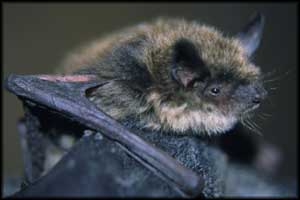 As part of her research projects, Cori has captured >6000 bats and >30 species. She has handled more than enough of these little brown bats, the most widespread species in North America. As part of her PhD Research, Cori discovered that 2 supposed subspecies of little brown bats, recently proposed to be separate species based on mitochondrial DNA, are actually just one interbreeding group. She has therefore proposed that one of the little brown subspecies designations be dropped and the others thoroughly reviewed. This research is published in the Canadian Journal of Zoology.
As part of her research projects, Cori has captured >6000 bats and >30 species. She has handled more than enough of these little brown bats, the most widespread species in North America. As part of her PhD Research, Cori discovered that 2 supposed subspecies of little brown bats, recently proposed to be separate species based on mitochondrial DNA, are actually just one interbreeding group. She has therefore proposed that one of the little brown subspecies designations be dropped and the others thoroughly reviewed. This research is published in the Canadian Journal of Zoology.
 Most species of bats typically have only one young per year, called a pup, shown at left. In her MSc. research, Cori found that bats roosting in buildings lead a better life than those roosting in natural rock crevices. One benefit to building-roosting bats is that they typically give birth earlier, which provides extra growing time for the pup before hibernation.
Most species of bats typically have only one young per year, called a pup, shown at left. In her MSc. research, Cori found that bats roosting in buildings lead a better life than those roosting in natural rock crevices. One benefit to building-roosting bats is that they typically give birth earlier, which provides extra growing time for the pup before hibernation.
 Cori’s MSc and PhD work focused on these two species of bats: western small-footed [left], and big brown bat [below, right]. In her MSc work Cori described summer roosts of big brown bats in relation to their physiology [torpor-daily cooling of their bodies to save energy].
Cori’s MSc and PhD work focused on these two species of bats: western small-footed [left], and big brown bat [below, right]. In her MSc work Cori described summer roosts of big brown bats in relation to their physiology [torpor-daily cooling of their bodies to save energy]. 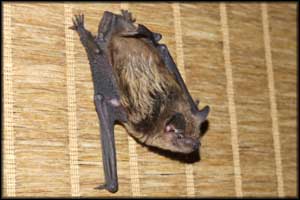 In her PhD work she described summer roosts of western small-footed bats, and winter roosts of big brown bats. The main focus of Cori’s PhD research, however, was the landscape genetics of western small-footed bats, big brown bats, and little brown bats. Cori determined that river topography influences breeding and dispersal of these species to varying degrees.
In her PhD work she described summer roosts of western small-footed bats, and winter roosts of big brown bats. The main focus of Cori’s PhD research, however, was the landscape genetics of western small-footed bats, big brown bats, and little brown bats. Cori determined that river topography influences breeding and dispersal of these species to varying degrees.
 Pictured at right is a Townsends’ big-eared bat that Cori captured in north-central Montana. Her work there extended the range of this species in Montana and increased the number of known maternity colonies in the state at the time from 1 to 3.
Pictured at right is a Townsends’ big-eared bat that Cori captured in north-central Montana. Her work there extended the range of this species in Montana and increased the number of known maternity colonies in the state at the time from 1 to 3.
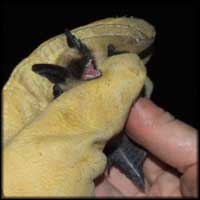 In the photo at left, Cori holds a western long-eared bat that she captured in the Northwest Territories as part of 2006 survey of Nahanni National Park. The capture of this species was a huge success, as this was the most northern record of this North American species.
In the photo at left, Cori holds a western long-eared bat that she captured in the Northwest Territories as part of 2006 survey of Nahanni National Park. The capture of this species was a huge success, as this was the most northern record of this North American species.
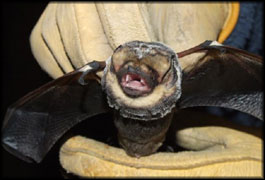 The Hoary Bat, pictured at right, is the largest species of bat in Canada. It is a migratory species, meaning that it moves south for the winter rather than hibernating in Canada like most other species. Other migratory species of bats include Red Bats and Silver-haired Bats. Migratory bats are the most common species showing up dead under wind turbines; most fatalities occur during the fall migration.
The Hoary Bat, pictured at right, is the largest species of bat in Canada. It is a migratory species, meaning that it moves south for the winter rather than hibernating in Canada like most other species. Other migratory species of bats include Red Bats and Silver-haired Bats. Migratory bats are the most common species showing up dead under wind turbines; most fatalities occur during the fall migration.
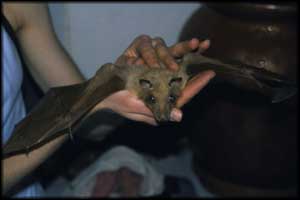 Cori worked with Dr. Brock Fenton on two projects, one in Belize and another in South Africa. This Wahlberg’s epauleted bat, left, is just one of the amazing bat species that were captured in South Africa. There are 2 main types of bats in the world, Megachiroptera and Microchiroptera. While all bats in North America are Microchiropterans, this fruit bat is a Megachiropteran. Unlike Microchiropterans, Megachiropterans are ‘old world’ bats only, and do not produce ultrasound [do not echolocate]. They navigate the night skies using their eyes only, which makes them easier to catch in mist-nets.
Cori worked with Dr. Brock Fenton on two projects, one in Belize and another in South Africa. This Wahlberg’s epauleted bat, left, is just one of the amazing bat species that were captured in South Africa. There are 2 main types of bats in the world, Megachiroptera and Microchiroptera. While all bats in North America are Microchiropterans, this fruit bat is a Megachiropteran. Unlike Microchiropterans, Megachiropterans are ‘old world’ bats only, and do not produce ultrasound [do not echolocate]. They navigate the night skies using their eyes only, which makes them easier to catch in mist-nets.
